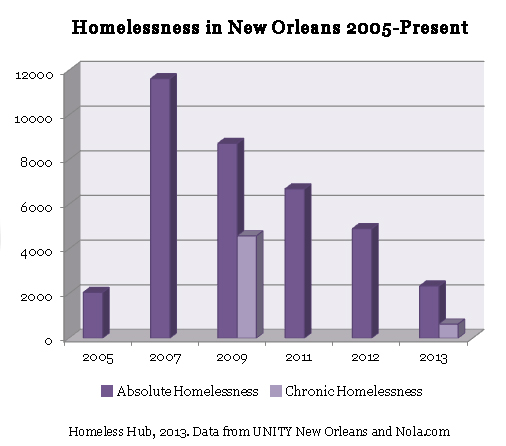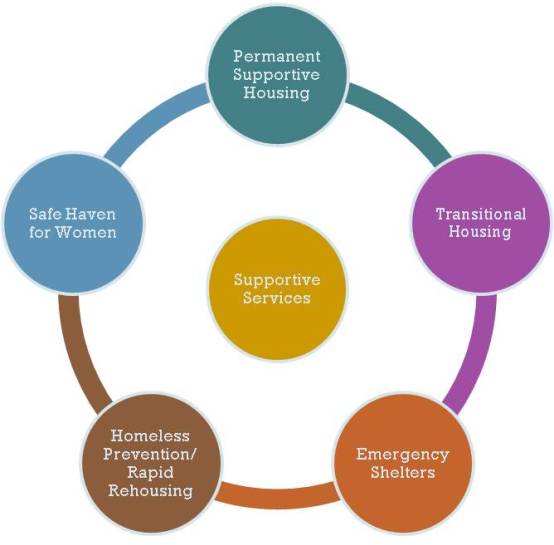The National Alliance to End Homelessness conference is happening this week in Washington and I’ve been following the hashtag #NAEH13 to see what’s new in research and homelessness. Iain de Jong (@OrgCode) posted the following: “New Orleans on track to end chronic homelessness by 2015. Huge high five! #NAEH13”
My first reaction, and my reply tweet to him, was “@OrgCode hmm. I'd be interested to see the research. lose 25% plus of your most at-risk pop'n & have hundreds of bldgs for squatters...”
But I decided to do a bit of research – I am after all a PhD student working at a pan-Canadian research network – before being too hasty. Turns out, there may be some truth to it – at least in terms of how it looks on paper. New Orleans, Louisiana (NOLA) has made some great strides in ending, or at least reducing, homelessness.
In a post on OneCPDResourceExchange last week entitled “SNAPS Weekly Focus Guest Blog: Working Together to End Homelessness”, Martha Kegel, Executive Director, UNITY of Greater New Orleans and Stacy Horn Koch, Director of Homeless Policy, City of New Orleans discuss the successes of the plan to end homelessness in New Orleans.
The stats about decreases in homelessness certainly present a clear picture of a dramatic increase (after Hurricane Katrina) and a dramatic decrease. Prior to Hurricane Katrina, there were 2,051 homeless people in New Orleans; two years later that number had jumped to 11,619 people. This number has been steadily declining; in 2009 it dropped to 8,725 and then to 4,903 in 2012. Currently, the number stands at 2,337 – a 47% decrease from last year.

As the chart makes it very clear; homelessness is on the decrease and in a big way, in New Orleans. Kegel and Horn Koch state that the key problem was linked to the impacts of Hurricane Katrina “Just a few years ago, New Orleans had one of the nation’s highest rates of chronic homelessness. This distressing phenomenon was largely due to the lingering effects of the Hurricane Katrina levee failures in 2005, which wiped out the city’s stock of affordable housing, shattered the health and behavioral health systems and scattered the extended family and community networks on which so many vulnerable people once relied.”

The success in reducing homelessness lies with the City of New Orleans, UNITY of Greater New Orleans and the 63 agencies who are part of the Continuum of Care. This partnership model is very much in line with what we are constantly promoting here at the Homeless Hub, the need for a “systems response” to ending homelessness. The network of agencies work together to help find solutions –systemic and individual—to homelessness in New Orleans.
This model has led to some incredible successes. Not only has total homelessness been reduced but there has also been a focus on chronic homelessness. This has decreased 85% since 2009 – from 4,579 to 633. Kegel and Horn Koch highlight this and say, “What was unimaginable only a few years ago is now within sight: New Orleans is on track to become one of the first cities to eliminate the long-term homelessness of people with disabilities, in line with the federal plan to end chronic homelessness by 2015.”
This has been noted elsewhere as well. In 2011, Community Solutions (formerly Common Ground) reported that “Despite overwhelming obstacles, New Orleans, a partner in the 100,000 Homes Campaign, now boasts the country’s highest housing placement rate for homeless adults.” This is a clear part of New Orleans’ 10 year plan to end homelessness.
In addition to using the systems approach, NOLA is also being very strategic. They recognize that with thousands of abandoned buildings it’s easy for people to stay hidden if they choose. Outreach teams for UNITY concentrate on abandoned buildings as a way of tracking where people might be living. As this article from nola.com explains the city also captured unspent grants for recovery given to developers and is using them to build housing for homeless people and to provide rent subsidies. It also explains another strategy where “The New Orleans Redevelopment Authority is making 20 of its properties available for the program, offering each to developers for 10 percent of the appraised value or $1,345, whichever is higher.” This helps ensure that unused housing is being fixed up and that people who otherwise might remain homeless are getting housed.
The resources for people who are homeless, marginally housed, living in poverty or otherwise vulnerable in New Orleans is quite extensive. A great directory has been compiled by UNITY and can be found here.
But a few counter points:
- A study of geographic origin of homeless people in Houston found that nearly 2% were from Louisiana. While the study has some methodological challenges, this is nearly double the percentage from California, the next highest state of origin.
- An article in The Stranger from Seattle, points out that New Orleans’ rate of homelessness as a percentage of the population remains high compared to elsewhere.
- The extended family living situation common in New Orleans means that there could be a large number of “hidden homeless” people: those who are doubling up with family and friends.
- The New York Times Katrina diaspora map reminds us that people were flung far and wide post hurricane. Many of those who faced challenges returning were those with low incomes and other marginalization issues.
- There were many challenges for people who owned their homes in proving home ownership and right to title because of a casual inheritance system common in New Orleans. While that legislation was modified in 2009, prior to that it resulted in many people being homeless or facing challenges in being re-housed. Post 2009, many people who were homeless because of this policy were able to return home.
- There are still about 35,000 blighted properties in New Orleans. Even the best outreach teams can’t check every home, every night to make sure no one is sleeping there.
None of this discounts the successes that New Orleans has had. The progress it has made is nothing short of remarkable. But the broad, systemic problem of homelessness persists and it is going to need concentrated effort from many sectors to end it.
This article also appears in Tanya's Toronto2NOLA's blog. You can follow Tanya on twitter @TanyaMGulliver.

